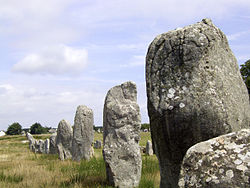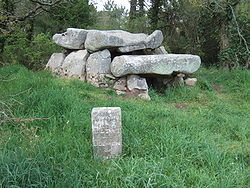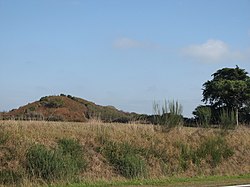Carnac stones
The Carnac stones are the largest collection of megalithic standing stones in the world.[1] The more than 3,000 prehistoric standing stones were cut from local rock and erected by the pre-Celtic people of Brittany.
The stones were erected at some stage during the Neolithic period, probably around 3300 BC, but some may be as old as 4500 BC.[2] The stones occur in a number of Neolithic sites around the French village of Carnac, in Brittany.[3] They include rows of stones (alignments), dolmens, tumuli and single menhirs.
In recent centuries, many of the sites have been neglected, with reports of dolmens being used as sheep shelters, chicken sheds or even ovens.[4] Stones have been removed to make way for roads, or used as building materials. The management of the sites is a controversial topic.[1][5]
Alignments
There are three major groups of stone rows — Ménec, Kermario and Kerlescan — which may have once formed a single group, but have been split up as stones were removed for other purposes.[6]
Ménec alignments
Eleven converging rows of menhirs stretching for 1,165 by 100 metres (3,822 by 328 ft). There is what may be the remains of stone circles at either end. According to the tourist office there is a "cromlech containing 71 stone blocks" at the western end and a very ruined cromlech at the eastern end. The largest stones, around 4 metres (13 ft) high, are at the wider, western end; the stones then become as small as 0.6m high along the length of the alignment before growing in height again toward the extreme eastern end.
Kermario (House of the Dead)[7] alignment
This fan-like layout recurs a little further along to the east in the Kermario alignment. It consists of 1029 stones[8] in ten columns, about 1,300 m (4,300 ft) in length.[6] A stone circle to the east end, where the stones are shorter, was revealed by aerial photography.[9]
Kerlescan alignments
A smaller group of 555 stones, further to the east of the other two sites. It is composed of 13 lines with a total length of about 800 metres (2,600 ft),[6] ranging in height from 80 cm (2 ft 7 in) to 4 m (13 ft).[10] At the extreme west, where the stones are tallest, there is a stone circle which has 39 stones. There may also be another stone circle to the north.[11]
Petit-Ménec alignments
A much smaller group, further east again of Kerlescan, falling within the commune of La Trinité-sur-Mer. These are now set in woods, and most are covered with moss and ivy.[12]
Tumuli
There are several tumuli, mounds of earth built up over a grave. In this area, they generally feature a passage leading to a central chamber which once held neolithic artefacts.
Saint-Michel
The tumulus of Saint-Michel was constructed between 5000 BC and 3400 BC. At its base it is 125 by 60 m (410 by 197 ft), and is 12 m (39 ft) high. It required 35,000 cubic metres (46,000 cu yd) of stone and earth. Its function was the same as that of the pyramids of Egypt: a tomb for the members of the ruling class. It contained various funerary objects, such as 15 stone chests, pottery, jewellery, most of which are currently held by the Museum of Prehistory of Carnac.[13] It was excavated in 1862 by René Galles with a series of vertical pits, digging down 8 m (26 ft). Le Rouzic also excavated it between 1900 and 1907 discovering the tomb and the stone chests.[14]
A chapel was built on top in 1663 but was rebuilt in 1813, before being destroyed in 1923. The current building is an identical reconstruction of the 1663 chapel, built in 1926.
Moustoir
Also known as Er Mané, it is a chamber tomb 85 m (279 ft) long, 35 m (115 ft) wide, and 5 m (16 ft) high. It has a dolmen at the west end, and two tombs at the east end.[13] A small menhir, approximately 3 m (10 ft) high, is nearby. 47°36′43″N 3°03′39″W / 47.6119°N 3.0608°W[15]
Dolmens
There are several dolmens scattered around the area. These dolmens are generally considered to have been tombs, however the acidic soil of Brittany has eroded away the bones. They were constructed with several large stones supporting a "capstone", then buried under a mound of earth. In many cases, the mound is no longer present, sometimes due to archeological excavation, and only the large stones remain, in various states of ruin.
- Er-Roc'h-Feutet: North, near the Chapelle de La Madelaine. Has a completely covered roof.
- La Madelaine:47°37′15″N 3°02′54″W / 47.6208°N 3.0482°W[16] A large dolmen measuring 12 by 5 m (39 by 16 ft), with a 5 m (16 ft) long broken capstone.[4] It is named after the nearby Chapelle de La Madelaine, which is still used.
- Kercado: A rare dolmen still covered by its original cairn. South of the Kermario alignments, it is 25 to 30 metres (82–98 ft) wide, 5 m (16 ft) high, and has a small menhir on top. Previously surrounded by a circle of small menhirs 4 m (13 ft) out,[14] the main passage is 6.5 m (21 ft) long and leads to a large chamber where numerous artifacts were found, including axes, pearls, arrow heads and pottery. It was constructed around 4600 BC and used for approximately 3,000 years.[14]
- Mané Brizil
- Kerlescan: A roughly rectangular mound, with only one capstone remaining. It is aligned east-to-west, with a passage entrance to the south.[11]
- Kermarquer: On a small hill, has two separate chambers.
- Mané-Kerioned (Pixies' mound or Grotte de Grionnec[14]): A group of three dolmens with layout unique in Brittany,[14] once covered by a tumulus. Whereas most groups of dolmens are parallel, these are arranged in a horse shoe. The largest of the three is at the east, 11 metres (36 ft).[13]
- Crucuno: A "classic" dolmen, with a 40 tonne, 7.6 metre tablestone resting on pillars roughly 1.8 m (5 ft 11 in) high. Prior to 1900, it was connected by a passage making it 24m long.[14]
Other formations
There are some individual menhirs and at least one other formation which do not fit into the above categories.
Manio quadrilateral
An arrangement of stones to form the perimeter of a large rectangle. Originally a "tertre tumulus" with a central mound, it is 37 m (121 ft) long, and aligned to east of northeast. The quadrilateral is 10 m (33 ft) wide to the east, but only 7 m (23 ft) wide at the west.[17]
Manio giant
Near the quadrilateral is a single massive menhir, now known as the "Giant". Over 6.5 m (21 ft) tall, it was re-erected around 1900 by Zacharie Le Rouzic,[14] and overlooks the nearby Kerlescan alignment.[18] 47°36′12″N 3°03′22″W / 47.6034°N 3.056°W[19]
Carnac Stones Media
Le Menec alignments with the Saint-Michel tumulus in the distance
References
- ↑ 1.0 1.1 "Megaliths of Carnac: Introduction". menhirs.tripod.com. Retrieved 2010-01-07.
- ↑ "Carnac Stones, Brittany". Sacred Destinations Travel Guide. Retrieved 2006-05-17.
- ↑ Carnac: megalithia.com
- ↑ 4.0 4.1 The Captain (3 January 2005). "La Madeleine dolmen Burial Chamber (Dolmen)". The Megalithic Portal and Megalith Map. Retrieved 2006-05-17.
- ↑ "Megaliths of Carnac: Standing Stones / Menhirs". megaliths.sherwoodonline.de. Retrieved 2010-01-07.
- ↑ 6.0 6.1 6.2 Leonard, R. Cedric (1 May 2006). "The Stones of Carnac". Archived from the original on 2012-04-01. Retrieved 2006-05-17.
- ↑ "Mané Kermario". Archived from the original on 2006-09-23. Retrieved 2006-05-17.
- ↑ "Holidays in Brittany". Archived from the original on 2005-10-27. Retrieved 2010-09-05.
- ↑ "Kermario". Myweb.tiscali.co.uk. Archived from the original on 2007-10-24. Retrieved 2009-05-05.
- ↑ (in French) http://www.dinosoria.com/dolmen_menhir.htm Archived 2021-02-04 at the Wayback Machine
- ↑ 11.0 11.1 "Kerlescan". Myweb.tiscali.co.uk. Archived from the original on 2012-04-01. Retrieved 2009-05-05.
- ↑ "Petit Ménec". Myweb.tiscali.co.uk. Archived from the original on 2012-04-01. Retrieved 2009-05-05.
- ↑ 13.0 13.1 13.2 "Office de Tourisme de Carnac". Web.archive.org. 2006-07-03. Archived from the original on 2006-07-03. Retrieved 2009-07-25.
{{cite web}}: CS1 maint: bot: original URL status unknown (link) - ↑ 14.0 14.1 14.2 14.3 14.4 14.5 14.6 Annick Jacq. "Carnac". Bretagne-celtic.com. Retrieved 2009-05-05.
- ↑ "The Megalithic Portal and Megalith Map: Moustoir tumulus Moustoir Er Mané] Chambered Tomb]". Megalithic.co.uk. Retrieved 2009-06-23.
- ↑ "The Megalithic Portal and Megalith Map: La Madeleine (Carnac) Burial Chamber (Dolmen)". Megalithic.co.uk. Retrieved 2009-05-05.
- ↑ "Manio Quadrilateral". Myweb.tiscali.co.uk. Archived from the original on 2012-04-01. Retrieved 2009-05-05.
- ↑ "Géant de Manio". Myweb.tiscali.co.uk. Archived from the original on 2007-10-24. Retrieved 2009-05-05.
- ↑ "The Megalithic Portal and Megalith Map: Geant du Manio Le Manio] Standing Stone (Menhir)]". Megalithic.co.uk. Retrieved 2009-06-23.
| Wikimedia Commons has media related to Lua error in Module:Commons_link at line 62: attempt to index field 'wikibase' (a nil value).. |
















